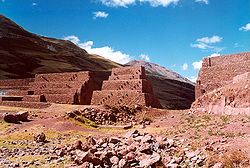Lucre | |
|---|---|
 | |
 | |
| Country | |
| Region | Cusco |
| Province | Quispicanchi |
| Founded | January 17, 1941 |
| Capital | Lucre |
| Area | |
• Total | 118.78 km2 (45.86 sq mi) |
| Elevation | 3,086 m (10,125 ft) |
| Population | |
• Total | 4,040 |
| • Density | 34/km2 (88/sq mi) |
| Time zone | UTC-5 (PET) |
| UBIGEO | 081208 |
The Lucre District is one of the twelve districts in the Quispicanchi Province in Peru. Created by Law No. 9295 on January 17, 1941, its capital is the town of Lucre.